Reflecting Telescopes- The Advantages and Disadvantages
Reflecting Telescopes use several mirrors instead of lenses to focus the light inside a telescope. Using mirrors instead of optical lenses dramatically decreases the cost of a new telescope and eliminates Chromatic Aberration.
Using a Primary and Secondary mirror inside the telescope increases the Focal Length. Increased Focal Length equates to a larger aperture, which provides more light. More light provides the ability to observe “dimmer” objects in the night sky.
Table of Contents
Reflecting Telescope Invention
The introduction and development of the Refracting Telescope began to open the night skies. New celestial discoveries were made every day. Yet, the design weakness of the refracting telescope led inventors to try to develop new telescopes.
Let’s take a quick primer on the Electromagnetic spectrum and Chromatic Aberration.
Electromagnetic Wavelengths
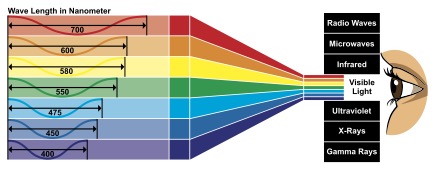
In the Visible Light portion of the Electromagnetic Spectrum (above image), the Wavelength of each light color is different. Shorter wavelengths (blues) of light have electrons and protons oscillating faster than longer wavelengths (Orange/Red). Longer wavelengths of light have electrons and protons oscillating slower than shorter wavelengths.
Different oscillation rates play out when the light passes through a telescope lens. The differences cause Chromatic Aberration.
Chromatic Aberration
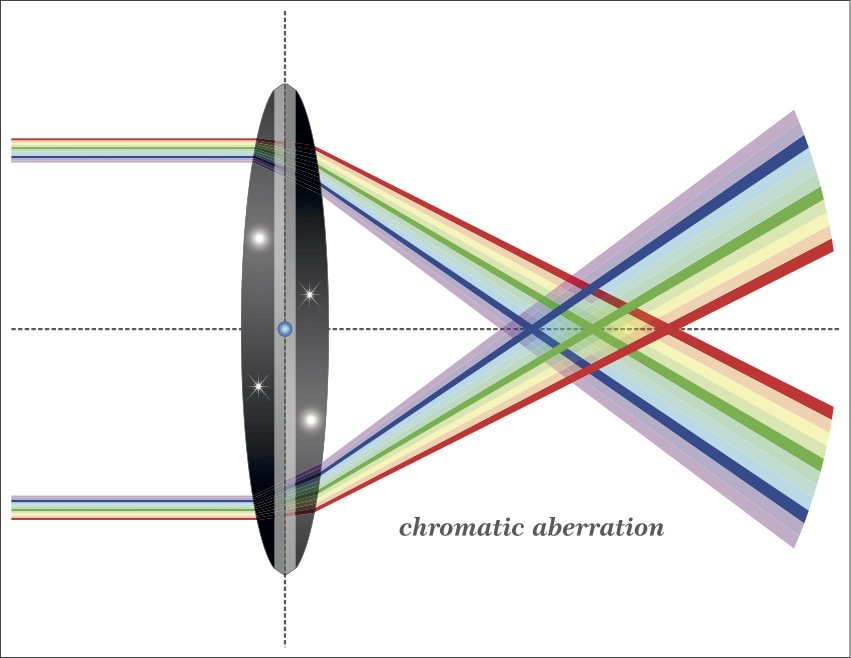
The image above demonstrates Chromatic Aberration.
- As the visible light travels into the lens of the telescope, the light disperses into separate wavelengths. (Refraction)
- The telescope’s lens has a Refractive Index. Refractive Index measures how much the light will bend when it passes from the air (we’re looking at the night skies!) to another object/medium (our telescope lens.)
- Each Wavelength has a different Refractive Index concerning the lens.
- The different light colors (wavelengths) will travel at different speeds through the lens.
- When the different wavelengths of the light exit the lens, refraction will occur again.
- In the image above, the light bends (or refracts) when it passes from the outer end of the lens into the lens.
- The light bends again (or refracts) when it leaves the lens.
- Shorter wavelengths refract (blue) more than longer wavelengths (red.)
- As a result of the refraction variances, different wavelengths focus in different positions. A shadow appears in the image.
Who Invented the Reflecting Telescope?
James Gregory published a paper outlining a reflecting telescope design in 1663. While Gregory was the first to document his concept, he didn’t build a functional telescope. Isaac Newton made, demonstrated, and recorded his version of the reflecting telescope in 1668.
Newton received the lion’s share of the recognition, but Gregory invented the reflecting telescope. The focus (good one, huh?!?) of Newton’s work was the elimination of Chromatic Aberration.
Glass lenses, or optics, have a refractive index. Mirrors don’t have a refractive index, so the issue of Chromatic Aberration is negated.
How Does A Reflecting Telescope Work?
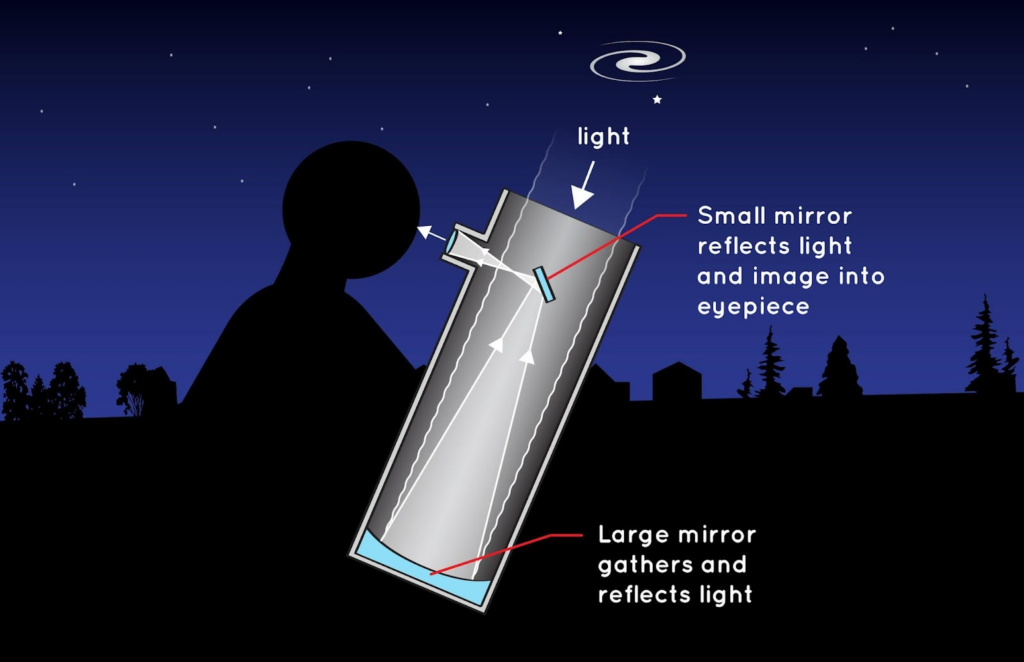
As seen in the image above,
- Light enters the end of the telescope “aimed” at the night skies.
- The light travels through the telescope and strikes Objective Mirror at the far end of the telescope.
- The light is reflected (not bent like a refractor telescope) back up the telescope. The curved shape of the objective mirror forces the light to contract as it travels away from the mirror.
- The light strikes a Reflecting mirror that’s positioned at a 45-degree angle.
- The light is reflected at a 90-degree angle to an Eye Piece.
- The user (that’s you!) places their eye near the Eye Piece for viewing.
Advantages and Disadvantages of Reflector Telescopes
There are plus and minus to consider when you’re looking to purchase a reflector telescope.
ReflectingTelescope Benefits
- No Chromatic Aberration!
- Cheaper to manufacture due to the lack of a lens in the telescope.
- Compact
- Larger apertures than refractor telescopes equal more light to the image.
- Shorter focal ranges equate to high-quality astrophotography.
ReflectingTelescope Disadvantages
- Collimation is required regularly.
- It takes longer to acclimate to outdoor temperatures. Thermal expansion of the mirrors takes time when you move the telescope from indoors to outdoors.
- Requires regular internal cleaning.
- Reduced size from refractor telescopes, but may “pack” more hardware internally. The weight/bulk may be more than a refractor telescope.
Different Types of Reflecting Telescopes
When you search for a reflecting telescope, you’ll find several different “flavors” of reflecting telescopes. Let’s take a look at each type.
Newtonian
Newtonians are the most popular Reflector Telescope type.
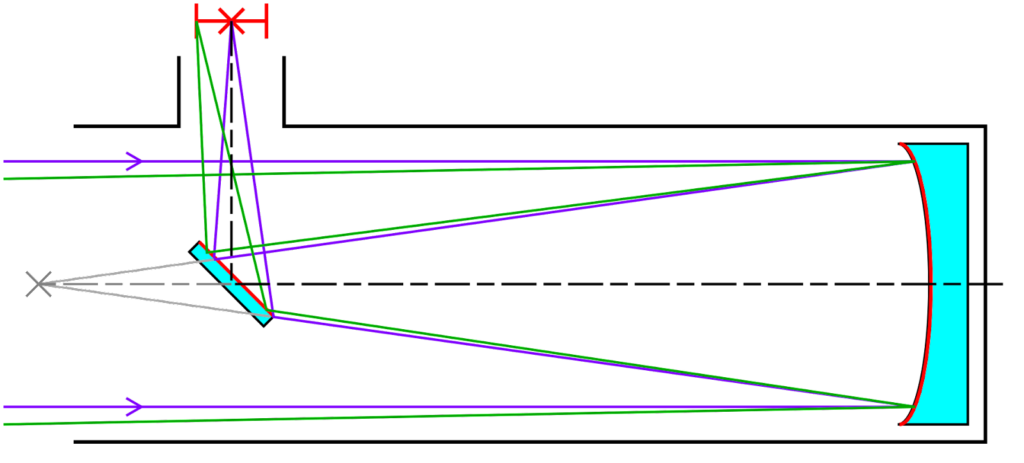
- Light enters the telescope (purple arrows) and travels to the mirror a the far end of the telescope.
- The primary mirror (blue) is (typically) a Concave Mirror.
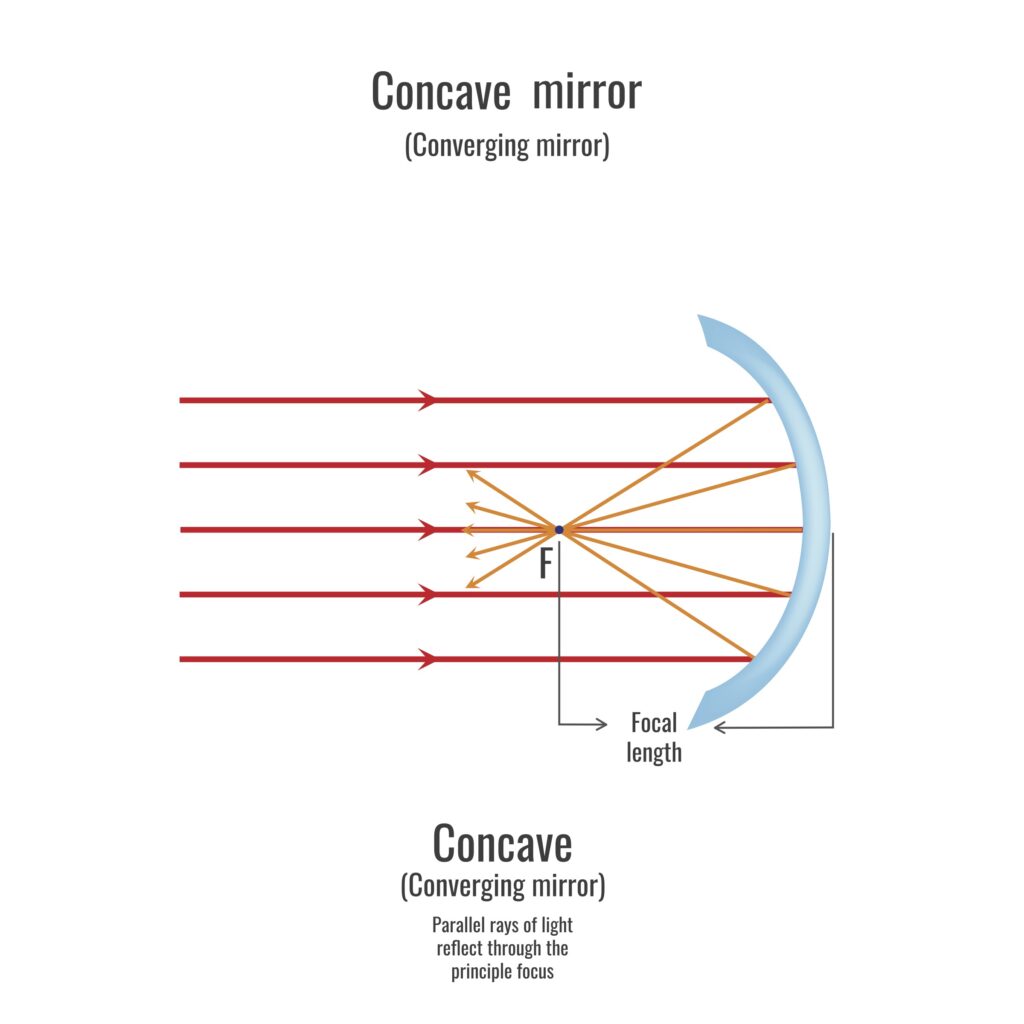
- In the image above, you can see how the curvature of the mirror reflects the light toward the center/entrance of the telescope tube.
- The light strikes a second mirror, called the secondary mirror.
- The secondary mirror reflects the light towards the side of the telescope tube.
- An eyepiece located on the side of the telescope is inserted into the telescope.
- Manual focusing occurs by twisting a focusing knob that will move the eyepiece closer or further away from the secondary mirror.
Dobsonians
A Dobsonian often “pops” up when you’re searching for telescopes. Fundamentally, Dobsonian and Newtonian telescopes are the same. The difference between the telescope types is the mounts.
Dobsonian Mount:
A Dobsonian Mount is an altazimuth mount. The mount allows movement in both vertical (altitude) and horizontal (azimuth).
Newtonian Mount:
A Newtonian Mount is an equatorial mount. The mount aligns with the rotation of the earth. It’s easier to track objects in the sky with an equatorial mount.
Cassegrain
A Cassegain telescope uses both convex and concave mirrors.

In the image the purple and green lines represent the light path as it travels through the telescope.
- Light enters the telescope and travels to the rear of the telescope.
- The light strikes the Primary Mirror (concave-shaped) and is reflected toward the center/entrance of the telescope tube.
- The light strikes a second mirror (convex shaped) and is reflected toward the eyepiece.
- A hole in the center of the Primary Mirror allows the light to pass through the mirror and out the eyepiece.
Reflecting Telescopes Wrap up
| Telescope Name | Orion 8944 SkyQuest XT6 Classic Dobsonian | SolorMark 130EQ Newtonian | Celestron 6SE |
| Telescope Type | Dobsonian | Newtonian | Cassegrain |
| Mount Type | Altazimuth | Equatorial | Altazimuth |
| Optical diameter | 150mm | 130mm | 150 mm |
| Focal length | 1200mm | 650mm | 1500 mm |
| Focal ratio | f/8.0 | f/5.0 | f/10 |
| Resolving power | 0.77arc*sec | 0.89arc*sec | 0.77 arc seconds |
Reflecting telescopes, as seen in the table above, come in many different configurations. What you plan to do with your reflecting telescope is a key decision in deciding what kind of telescope to purchase.
A Dobsian is a good choice for Deep Sky Observations but not for astrophotography due to their lack of motorized mounts.
A Newtonian is a good choice for observing planets, stars clusters, and galaxies. Good choice for astrophotography.
A Cassegrain is an excellent all-around choice but is best suited for high-magnification viewing of planets and Deep Sky Observations—an ideal choice for astrophotography.
